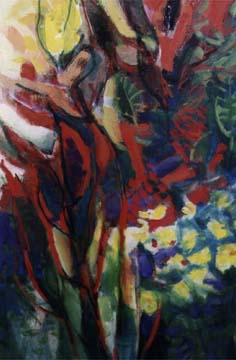In the foreword to his last one-man show, in 2002, Isaiah Boodhoo made this statement about his work: “Painting, for me is a compulsive activity . . . My many decades of experiencing the world — the variety of visual experiences from the landscape, from literature, from the artworks of other people — have provided stimuli and ideas. Also, I enjoy the very act of painting: I enjoy the sensuality of applying paint, of feeling the ‘butterness’ of pigment and the springiness of a taut canvas. I thrill to the changes on the canvas surface, sometimes deliberate, sometimes serendipitous”.
That sense of thrill, both in Boodhoo’s work and in his personality, touched many people. Contemporary Trinidadian artists as various as Shastri Maharaj, Ken Crichlow, Makemba Kunle, and Christopher Cozier have hailed his influence; artist and musician Pat Bishop has called Boodhoo “as important a painter as we have ever produced in the history of modern Trinidad . . . Some of us have a gift; and many of us are ‘truthful’ and consistent painters. Few can claim that all of these qualities are characteristic of what we produce. But Boodhoo can safely make this claim.”
Isaiah James Boodhoo, who died on 28 February, 2004, was the son of an estate labourer from Upper Guaico in central Trinidad. Though of East Indian descent, he joked that his name reflected the cosmopolitan nature of Trinidad, with its Hindu, Muslim, and Christian influences. At Naparima Training College in the 1950s, he was taught by the artist M.P. Alladin, whose impressionist style of painting and themes of Trinidad folk culture influenced the young Boodhoo. In 1958 he was awarded a scholarship to study at the Brighton College of Art in the United Kingdom, where he earned a national diploma in design before returning to Trinidad in 1962, to teach.
Boodhoo’s work at this time was more representational in style, reflecting the growing nationalism of the early days of independence. But in the US, where he studied in the late 1960s and early 1970s, he came under the influence of West Coast painters with their abstract modernist style and commitment to political activism. His one-man exhibition at the Trinidad and Tobago National Gallery in 1970, when Black Power protests were taking place all over the country, reflected that period of social unrest.
In 1974, Boodhoo was appointed curriculum supervisor at the ministry of education. Later, from 1978 to 1996, he served as chief convenor and later chief examiner for art and craft at the Caribbean Examinations Council, making him responsible for art education throughout the Caribbean. He retired from his government position in 1989 to work full-time on his painting, regretting that he had not left earlier.
Over the 50-year span of his career, Boodhoo held 11 one-man exhibitions, and also represented Trinidad and Tobago at three São Paolo Bienals; he participated in group exhibitions in London, Montreal, and Washington. He was an oil painter with a strong sense of colour, who explored a variety of styles, from representational to semi-abstract, depending on the subject matter. He moved from representing pure landscape to social and political commentary, to a more lyrical celebration of the beauty of Trinidad and its people.
Compiling crosswords was one of Boodhoo’s chief hobbies, and over the years he published thousands of them in various newspapers and magazines, including Caribbean Beat — every issue of this magazine, from the first, published in 1992, to the one you hold in your hands, has featured one of Boodhoo’s crosswords. He was also an accomplished writer, whose novel Between Two Seasons was published in 1994.
In recent years he suffered from kidney disease, and endured dialysis twice a week. Nevertheless, he remained as cheerful as ever. At the time of his death, Boodhoo was working with Ken Crichlow and National Museum curator Vel Lewis on a major retrospective of his paintings, originally planned for later in 2004. Let us hope it proceeds as planned, giving us another chance to admire the beautiful, spiritual canvases of a major Caribbean artist.






















